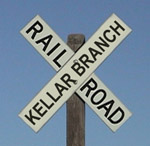 In their filing submitted Friday, but just posted to the Surface Transportation Board’s website today, Pioneer Industrial Railway has responded to Central Illinois Railroad’s recent petition to “hold in abeyance” the STB’s November 19 ruling.
In their filing submitted Friday, but just posted to the Surface Transportation Board’s website today, Pioneer Industrial Railway has responded to Central Illinois Railroad’s recent petition to “hold in abeyance” the STB’s November 19 ruling.
Pioneer argues that Central Illinois Railroad (CIRY) has no legal basis to request that a decision be “held in abeyance,” and that CIRY is only filing under that terminology because they missed the deadline to appeal the STB’s decision and request a “stay” of the decision. Pioneer also defends itself against the allegations made in CIRY’s filing. Here’s the summary conclusion:
As the Board’s recent General Railway decision put it, a party may not avoid the obligation of meeting the Board’s procedural standards merely by assigning a different label to its request for relief. But that is precisely what CIRY has done here. Knowing that it has missed the deadlines to request a stay (and knowing further that it could not satisfy the stay standards anyway), it merely gives its stay request a different name – a request to hold the matter in abeyance. Of course, CIRY’s is not really a request to hold matters in abeyance, as PIRY has clearly established above. Moreover, although CIRY seeks “modification” of the November 19 Decision, it has neither requested reopening of the Board’s decision nor did it file a timely petition for reconsideration. In short, and as has been thoroughly demonstrated above, CIRY lacks any legal basis for the relief it seeks and is merely attempting here to bypass proper agency procedure. The Board must not let CIRY make a mockery of correct Board processes, and it should therefore deny CIRY’s Petition for these reasons.
But even if the Board were to address the merits of CIRY’s Petition, it has not made a case for any of the relief it seeks. Rather, CIRY engages in the typical attempts to smear PIRY, makes false and irrelevant allegations, and otherwise does its utmost to dig in its heels in an effort to deprive PIRY of access to the line and to block PIRY from fulfilling its common carrier obligations to Carver and to any other shippers that way wish to use the line. For all of these reasons, as discussed more fully above, CIRY’s Petition should be denied, and the Board should make clear that CIRY must not block or attempt to impose delay on PIRY’s ongoing efforts to restore rail service on this line.
A couple of things from earlier in the filing I found interesting:
- Pioneer points out that CIRY claims it would be too costly to fix up the Kellar Branch track to provide service to Carver Lumber, but then states that it has spent $100,000 to fix up the Kellar Branch for the purposes of running a hi-rail vehicle of it:
One wonders why CIRY would be willing to spend $100,000 to permit it to operate a hi-rail vehicle over the line when CIRY claims that such an expenditure “vastly exceeds the gross amount of revenues that CIRY would likely earn.” Perhaps CIRY answers this question when it admits that it is using the line for the storage of carload quantities of hazardous materials. Could it be that CIRY is not really in the business of providing common carrier service but rather in the business of storing hazardous rail cars? Could it be that CIRY is using its status as a rail carrier to take advantage of STB preemption so as to prevent the City of Peoria and the State of Illinois from interfering with what is apparently a lucrative business, i.e. storing hazardous materials in rail cars? One doubts that CIRY is truly concerned about safety over the line when it is using the line for the storage of dangerous and hazardous materials. PIRY has no such plans and intends to do what it always did – operate a line of railroad for local customers.
This is an important distinction — CIRY is an out-of-town company that is using the city’s tracks to store hazmat cars from out of town. Pioneer, on the other hand, is a local company, headquartered in Peoria, that simply wants to serve local shippers on the Kellar Branch.
- Pioneer also points out that CIRY filed this petition on its own, and that neither the City of Peoria nor the Village of Peoria Heights joined in this petition:
As an initial matter, it is telling that the Cities, who are the actual owners of the Kellar Branch and who filed the adverse discontinuance in the first place, have not filed a request for stay, a petition to reopen, or joined in CIRY’s Petition. One would presume that, if the Cities continued to object to having PIRY on the line, they would be the ones taking legal action, but they have not done so. Indeed, the city council for the City on November 27 voted 6-4 to reject a motion for continued legal adversity against PIRY. The majority of the city council indicated a willingness to negotiate with PIRY, CIRY, and others to resolve the outstanding issues. Granting the Petition would simply undermine the city council’s desire to negotiate a settlement rather than to litigate.
While all that is true, it is worth mentioning that the Village of Peoria Heights did, in fact, pass the resolution that the City of Peoria defeated. It’s also worth mentioning that Peoria Heights has not footed any of the legal bills associated with the efforts to turn the Kellar Branch into a hiking trail over the past decade-plus. Hopefully, someday, all the parties will be able to work out a mutually beneficial agreement and all this acrimony can come to an end.
 When Morris decided not to run for reelection as a city councilman, he said it was so he could spend more time with his family. (May 1, 2007: “[T]he most important thing for me is to spend more time with my family.”) Yet he’s now embarked on a quest to become a U. S. Congressman, which will mean even less time with his family. Why the change?
When Morris decided not to run for reelection as a city councilman, he said it was so he could spend more time with his family. (May 1, 2007: “[T]he most important thing for me is to spend more time with my family.”) Yet he’s now embarked on a quest to become a U. S. Congressman, which will mean even less time with his family. Why the change?

 In their filing submitted Friday, but just
In their filing submitted Friday, but just